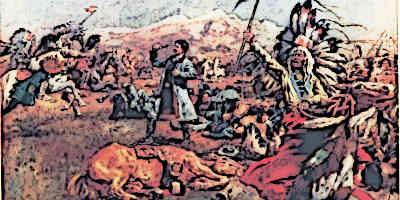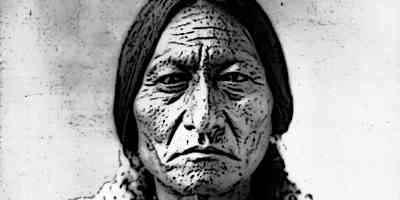Crazy Horse
Crazy Horse was a famous Native American Indian Warrior, Brave and Courageous Crazy Horse belonged to the The Sioux Nation...
Sitting Bull
Sitting Bull was a brave warrior who was part of the Sioux Nation and fought in the Red Cloud's war
Tecumseh
'Tecumseh' was an important leader of the American Indian Shawnee tribe. He was a great Prophet who had spiritual visions..
Geronimo
Geronimo was an Apache warrior who later became the chief of the Apache tribes. The Mexican forces killed his family while the state of modern-day Arizona was still under Mexican control.
So Geronimo fought against the Mexicans. Later Arizona came into the ownership of USA. The U.S. government forced Apache tribes out of their lands and on to reservation sites. Geronimo didn’t like this and escaped the reservation.
He fought off the U.S. troops sent to bring him back. He was later brought back but escaped again. After escaping a number of times, fighting off the U.S. troops and attacking the white settlers, Geronimo finally surrendered in 1886.
https://www.youtube.com/watch?v=BmZzSC06CdE
Chief Joseph
Chief Joseph belonged to the Nez Perce tribe. In the 1870s, USA had expanded all the way from the eastern coast to the western coast. In the Pacific Northwest, American settlers came across the Nez Perce who already lived in the area.
The Native Indians resented the white men encroaching upon their lands. The U.S. army then forcibly removed the Nez Perce to a reservation site.
Chief Joseph, along with a band of Nez Perce, resisted. He refused to go to the reservation site and took 700 people of his tribe on a journey towards Canada. He hoped that in Canada they would be allowed to live freely.
This journey was 1170 miles long. On the journey, the U.S. army pursued Chief Joseph and his people. He was able to keep ahead of the army, fight them off in a number of encounters and continue the march.
Finally, the army caught up with the Nez Perce only a few miles from the Canadian border. Chief Joseph became popular for his brilliance of strategy, bravery and humanity in warfare.
Tecumseh
Tecumseh was a famous Native American warrior who belonged to the Shawnee tribe. His tribe was forced out of the Ohio Valley area after being defeated by the militia of Virginia.
This angered Tecumseh who spent his life fighting against the U.S. forces. He gathered a large group of Native Indian warriors and started a large-scale conflict in 1810. This conflict became known as Tecumseh’s War.
Although defeated in this war, Tecumseh joined the British forces in the War of 1812. He was later killed in a battle in 1813.
Crazy Horse
Crazy Horse was a war chief of the Lakota tribe. His tribe had occupied the Great Plains area for a long time. When American settlers started arriving in the region, Crazy Horse and other Lakota warriors decided to fight them.
He fought a number of battles against the U.S. army including the famous Battle of the Little Bighorn where he played a major role in securing victory.
After participating in the Great Sioux War which lasted from 1876 to 1877, Crazy Horse surrendered in 1877. He was later wounded by a military guard during his imprisonment and died of his wounds.
Red Cloud
Red Cloud belonged to the Lakota tribe. When the U.S. army tried to force the Native Indians out of their territories in the Wyoming and Montana territories, Red Cloud decided to fight back.
He waged a successful war against the U.S. army from 1866 to 1868. This became known as Red Cloud’s War. Red Cloud became famous for being one of the very few Indian warriors who successfully fought the U.S. troops.
The U.S. government finally decided to sign a peace treaty with him. After signing the peace treaty, Red Cloud moved to a reservation site together with his tribe.
https://www.youtube.com/watch?v=DxB6k_Y3koU
Sitting Bull
Sitting Bull was one of the most widely known and famous Native American warriors. During the 19th century, he participated in a number of wars against the U.S. army.
He led large bands of warriors in a number of battles. He fought in Red Cloud’s War as well as the Great Sioux War of 1876. Sitting Bull led the Native American warriors in the famous Battle of the Little Bighorn.
In 1881, Sitting Bull surrendered to the U.S. forces after a long life of fighting them. He also participated in the famous Buffalo Bill’s Wild West show.
He lived the rest of his life at an Indian reservation site. In 1890, he was shot and killed during a scuffle when the Indian police tried to arrest him.
Black Hawk
Black Hawk was a famous warrior of the Sauk tribe. He led a large band of Native American warriors in fighting the white settlers and soldiers. He wanted to force out the white settlers from the Sauk territories in the American Midwest.
In 1812, he joined the British War of 1812 against USA. Later, he started another war which became known as the Black Hawk War. This war took place in 1832.
He was later captured by the U.S. forces and imprisoned. During the late part of his year, he worked with an interpreter to write and publish his autobiography.
Cochise
Cochise was a warrior and chief of the Apache tribe. His tribe lived in areas that are a part of northern Mexico and southern Arizona today. When white and Mexican settlers started arriving in the area, Cochise and his people didn’t like their encroachment.
This eventually led Cochise to fight the U.S. troops and white settlers. He and his warriors fought for nearly a decade, raiding the settlements and fighting minor engagements with the soldiers. In 1872, he finally agreed to a peace treaty with the U.S. government and went off to live at a reservation site.


